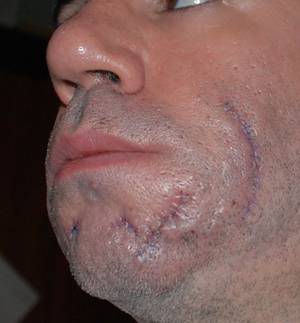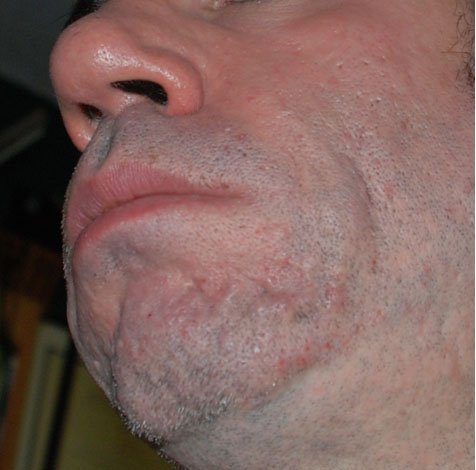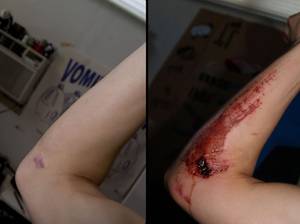Healing Without Scars
Interview with
 Helen Scales: This is The Naked Scientists and we're talking about skin, that wonderful stuff that keeps up healthy, keeps us dry. Comes in all sorts of colours, and one of the things that skin does very well, if all goes well, is it heals if we cut ourselves. What happens when skin cells are traumatised is that cells called fibroblast--produce fibrous tissues made of collagen and that helps close up the wound, but inevitably a little bit too much fibrous material is produced and that can lead to scarring. Well, now a team at Bristol University has discovered how these fibroblast are turned on by another class of inflammatory cells called macrophages and if the signal between the two is blocked it's possible to make wounds heal, with much smaller scars.
Helen Scales: This is The Naked Scientists and we're talking about skin, that wonderful stuff that keeps up healthy, keeps us dry. Comes in all sorts of colours, and one of the things that skin does very well, if all goes well, is it heals if we cut ourselves. What happens when skin cells are traumatised is that cells called fibroblast--produce fibrous tissues made of collagen and that helps close up the wound, but inevitably a little bit too much fibrous material is produced and that can lead to scarring. Well, now a team at Bristol University has discovered how these fibroblast are turned on by another class of inflammatory cells called macrophages and if the signal between the two is blocked it's possible to make wounds heal, with much smaller scars.
We sent Ben Valsler to Bristol where he met Professor Paul Martin.
 Paul Martin: When our skin is damaged, wounded; fallen out in a scratch--our knee, or something, a whole cascade of events is initiated. Very quickly you forms a scab, and underneath that scab the tissues are trying to repair the hole in the skin, and there are several layers to the skin: the upper layer is epithelial layer and that's got to crawl forwards and close over.Beneath that there is a layer called dermis or connective tissue, and that tissue when it repairs, repairs with a scar.
Paul Martin: When our skin is damaged, wounded; fallen out in a scratch--our knee, or something, a whole cascade of events is initiated. Very quickly you forms a scab, and underneath that scab the tissues are trying to repair the hole in the skin, and there are several layers to the skin: the upper layer is epithelial layer and that's got to crawl forwards and close over.Beneath that there is a layer called dermis or connective tissue, and that tissue when it repairs, repairs with a scar.
So this response to tissue damage repair is not perfect. It turns out the reason we form a scar in that dermal layer--the reason we contract the connective tissue down is because inflammatory cells, white blood cells, rush out of blood vessels by the wound to kill bugs. As well as doing that, they talk to the wound fibroblast, and it seems that one of their conversations is just like a bad bi-product of their normal job, is to tell these fibroblasts to form a scar. So what we attempted to do was to figure out what that conversation was and what, in molecular terms, the fibroblasts did in response to hearing that conversation; and we identified as a hot candidate, a gene called osteopontin. It looks as though it screamed on in wound fibroblasts when they saw inflammatory cells.
We had a mouse that didn't raise a big inflammatory response, and when that happened that mouse healed its wounds without a scar, and didn't switch on the gene osteopontin. So there's a correlation: inflammation osteopontin; osteopontin scar, but that's only a correlation. It doesn't prove osteopontin is the bad boy. So what a Japanese post doc, Ryoichi Mori did, was to knock down in a normal mouse, this gene osteopontin; he knocked it down by delivering in a pluronic gel--this is a gel that's liquid at cold temperatures. As soon as you apply it to the body--to the mouse wound--37º, it hardens up, fills the would gap and oozing out of it is an antisense oligo which knocks down this gene osteopontin.
When he did that he found that these wounds that should have scarred; didn't. So that now demonstrated the correlation, osteopontin scar, was functional. That osteopontin was the reason they scarred. So then Tanya Shaw, another post doc in my lab, what she asked was, what are those inflammatory cells telling the fibroblast that makes the fibroblast switch on this gene osteopontin which leads to scars? So she knew that there were a whole list of growth factors that macrophages are known to make. So she took some fibroblasts in a dish and she threw all of those factors, one at a time, on to those fibroblasts until she found one that caused the fibroblast to scream on osteopontin. She identified one factor, PDGF: platelet-derived growth factor that looked as though it could do the job.
 But the sort of - the real tasty bit of experiment was she then bathed the fibroblast in an antibody that blocks PDGF, and then she applied macrophages to the fibroblast, so those macrophages now pump out all the signals that they normally make in wounds, but the fibroblasts did not respond by switching on osteopontin. So that proved that macrophages are talking to fibroblasts via this signal PDGF and that was what, in a wound situation, was telling fibroblast to switch on osteopontin; and osteopontin was causal of scarring.
But the sort of - the real tasty bit of experiment was she then bathed the fibroblast in an antibody that blocks PDGF, and then she applied macrophages to the fibroblast, so those macrophages now pump out all the signals that they normally make in wounds, but the fibroblasts did not respond by switching on osteopontin. So that proved that macrophages are talking to fibroblasts via this signal PDGF and that was what, in a wound situation, was telling fibroblast to switch on osteopontin; and osteopontin was causal of scarring.
Ben Valsler: So just by watching what happens with different chemical messengers and different genes being activated, you actually were able to spot several different angles of attack, in order to allow wounds to heal healthily but prevent scarring. But what does osteopontin do in healthy, normal, non-wounded tissue? Are we running the risk of blocking a gene that's actually quite important?
Paul Martin: We absolutely are. My own impression is--and this is why you need to do, you know, very careful, gentle clinical trials. Certainly in the mouse experiments that we've done these wounds that have been treated with an agent that blocks osteopontin, heal the wounds better, faster and without scarring. Whether that will translate into the clinic isn't clear, whether there will be some downstream problem isn't clear, I can't even guess the sort - Now, you asked what it does, you know, what the function of this gene is? Well it's called osteopontin; osteo-bone--it's involved in bone cell development in the early embryo. It has some signalling roles in immune cells, many of these multiple roles it has might be involved in the wounding situation. We don't know and we need to look hard.
Ben Valsler: There are some situations where wounds will heal without scarring inside the mouth. They tend not to scar at all, and foetal tissue in fact gets will heal without scarring. Could we look at these situations to see if there are other pathways we could look at that perhaps wouldn't run the risk of blocking genes that might otherwise be useful?
Paul Martin: Good idea--look! We are a lab that comes from developmental biological. We are interested in how tissues are built and understanding how tissues are built in embryos gives you clues how they might be rebuilt in the adult. We are one of the labs that has shown that embryonic tissue doesn't scar. Embryonic tissue, when you damage it, doesn't raise a robust inflammatory response and we think that's one of the reasons why it doesn't scar, it's because there is no inflammatory cells turn up at the wound, osteopontin doesn't come on, so we're trying replicate what works beautifully in an embryo in an adult essentially.
Now you asked about the mouth and that is an interesting situation. You're right it is a place in the human adult body that repairs very efficiently, rapidly--not totally without scars but certainly they're reduced. Oral tissue has a much reduced inflammatory response, a different sort of inflammatory response. Maybe that's because the saliva in the mouth and in the saliva are anti-microbial activities and things, so you don't need such a robust inflammatory response.
- Previous Evolution of Skin Colours
- Next Curing Infant Jaundice










Comments
Add a comment